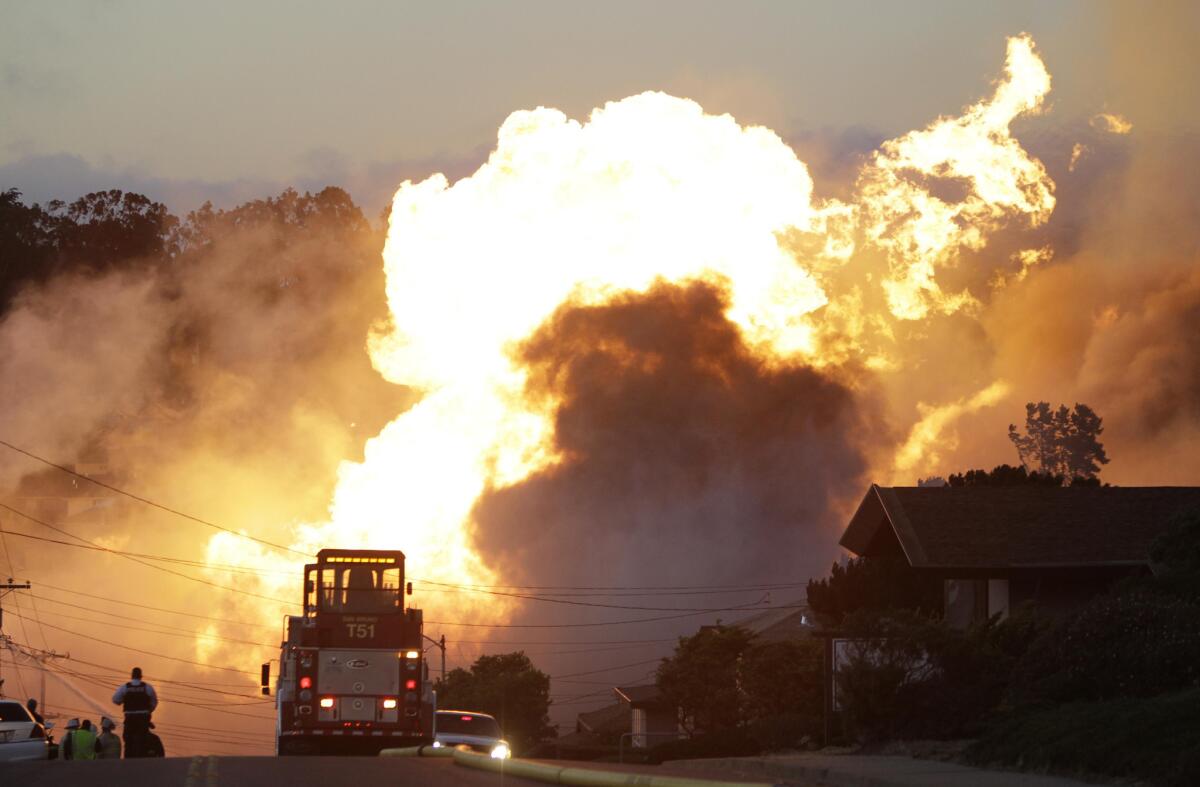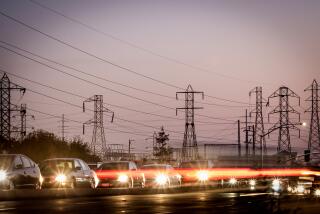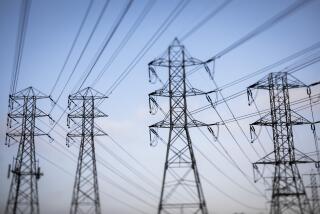California regulators fine PG&E a record $1.6 billion in San Bruno blast

A massive fire fueled by a ruptured Pacific Gas & Electric natural gas pipeline burns in San Bruno on Sept. 9, 2010.
Reporting from Sacramento — California regulators approved a record $1.6-billion fine against the state’s largest utility, Pacific Gas & Electric Co., even as the new president of the Public Utilities Commission publicly questioned the company’s commitment to safety.
The fine for violating state and federal pipeline safety standards was prompted by the 2010 explosion of a PG&E natural gas transmission line that killed eight people and leveled parts of a neighborhood in the San Francisco suburb of San Bruno.
The commission approved the measure by a 4-0 vote Thursday with Commissioner Mike Florio not participating.
In October, Florio removed himself from deliberating on the San Bruno case at the request of San Bruno city officials. They accused Florio of having improper, one-sided communications with PG&E executives. He said at the time he was unclear about the rules and would step aside.
The fine was the largest in PUC history and one of the largest paid by a U.S. utility, said PUC President Michael Picker. Total San Bruno-related penalties levied against PG&E now exceed $2.2 billon, he said.
After the vote, Picker said the utility spent heavily to improve its natural gas transmission system since the explosion. But he publicly questioned the depth of PG&E’s safety culture.
“I see a lot of unevenness, and that’s troubling me,” he said.
Picker told his colleagues that he plans to open an investigation “into the safety culture and practices at PG&E.”
Commissioner Catherine Sandoval said she supported Picker’s call for an investigation. PG&E, she said, has demonstrated “a whole host of failures … that start from the top.”
The Thursday vote and future actions, she said, “signal that we expect accountability and performance from utilities we regulate and from ourselves at the CPUC.”
The company said it would cooperate with regulators.
What’s more, PG&E does not expect to appeal the PUC’s decision, Chief Executive Tony Earley said.
“I want to be very clear — our focus is on moving forward to complete the important safety work we set out to do,” he said in a statement. “We’ve made tremendous progress but we have more to do and we are committed to doing it right.”
The entire $1.6-billion penalty will come from the company andits shareholders — not from ratepayers. The proceeds will be allocated to pipeline safety, taxpayers and customers.
In all, $850 million will be spent on improving PG&E’s entire natural gas transmission system; $300 million will go to the state’s general treasury; $400 million will be rebated to PG&E natural gas customers; and $50 million will pay for a variety of PUC safety activities.
In testimony before the vote, San Bruno Mayor Jim Ruane praised the commission’s large penalty. But he complained that the PUC did not heed the city’s call to create an independent panel to monitor PG&E’s safety program.
The mayor also criticized the commission for not agreeing to reimburse the city for its more than $2 million in legal costs for participating in PUC proceedings related to the disaster. Ruane vowed to pursue the monitoring issue with the California Legislature and state and federal law enforcement agencies investigating the blast, the PUC and the utility.
Victims and survivors of the San Bruno tragedy, who addressed the commission before the vote, said they were skeptical about promises from both PG&E and the PUC to improve safety.
Levying the fine, said Susan Bullis, who lost three family members in the San Bruno firestorm, is too little too late.
“I blame PG&E for the death of my family,” she said. “And I blame the PUC, the watchdog agency responsible for monitoring PG&E.”
Thursday’s penalty was more than 10 times greater than the previous highest fine of $146 million against Southern California Edison.
Twitter: @MarcLifsher
More to Read
Inside the business of entertainment
The Wide Shot brings you news, analysis and insights on everything from streaming wars to production — and what it all means for the future.
You may occasionally receive promotional content from the Los Angeles Times.











